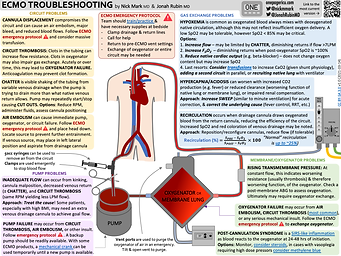ILLUSTRATIONS
Critical care medicine illustrations by Nick Mark from ICU One Pager based on an understanding of physiology and evidence-based medicine.
Temporary / External Cardiac Pacing
External cardiac pacing is a technique for temporarily treating brady- and tachydysryhthmias in the ICU. This #OnePager covers the basics, including types of pacing leads (transvenous vs epicardial, bipolar vs unipolar), pacing modes (VVI, DDD, etc), and a stepwise guide to initiating pacing.
Jan 22, 2021
56
Minnesota Tubes for Upper GI Bleeds
Occasionally medical and interventional therapies can’t stop an upper GI bleeds due to esophageal varices. In those rare cases, placement of a Minnesota Tube can be life-saving. This #OnePager reviews how Minnesota Tubes work & shows you how to safely place and secure them. There are also some great how-to videos that walk you through the process step by step.
Jan 29, 2021
25
Overview of Renal Replacement Therapy
Renal replacement therapies are commonly used in the ICU to remove excess fluid and clear the blood of endogenous and exogenous toxins. This ICU OnePager explains the physics & physiology of dialysis, discussing the key concepts (dialysis = diffusion, hemofiltration/ultrafiltration = convection) and the components of the dialysis circuit (pumps, dialyzer, dialysis solution, replacement fluid, etc). It also reviews all the confusing modes of dialysis: IHD, SLED, and CRRT including SCUF, CVVHF, CVVHD, and CVVHDF.
Feb 17, 2021
60
Determining Fluid Responsiveness
Fluids are beneficial when needed but harmful in excess. Determining when to give fluids is a foundational critical care skill. This ICU OnePager reviews how to measure CO including invasive techniques (pulse pressure variation, pulse contour analysis, pulmonary artery catheters), ultrasound techniques (LVOT and carotid VTI, IVC distensibility) and less invasive technqiues (NICOM, End-Tidal CO2, etc). It also discusses the maneuvers that we can perform to test for fluid responsiveness: Passive Leg Raise (PLR), Mini-bolus, PEEP challenge, and End-Expiratory Occlusion (EEO). As a bonus, we talk about emerging techniques (fluid tolerance testing, VEXUS) as well as some techniques that just refuse to die (CVP, IVC size, PCWP, etc)
Mar 22, 2021
78
Blood Product Transfusion
This OnePager reviews the basics of transfusion, the special types of blood products that can be ordered, and the transfusion reactions that can occur.
Jul 10, 2021
62
“Hot & Bothered” Hyperthermic Toxidromes
Five potentially life threatening toxidromes (sympathomimetic overdose, anticholinergic overdose, serotonin syndrome, neuroleptic malignant syndrome, and malignant hyperthermia) can all present with overlapping clinical features: hyperthermia, altered mental status/seizures, rhabdomyolysis. This OnePager reviews the features of each with historical/exam pearls to differentiate.
Oct 20, 2021
50
Lactic Acidosis
Lactate and Lactic acid are frequently used (& oft misunderstood) labs in the ICU. This OnePager reviews the physiology of why/how we produce lactic acid and breaks lactic acidosis into two categories: Impaired O2 Delivery (Type A Lactic Acidosis) and Impaired O2 clearance/utilization (Type B Lactic Acidosis). I also discuss the rare and easily missed Type D Lactic acidosis (due to bacterial production of the stereoisomer).
Jan 25, 2022
66
Abdominal Compartment Syndrome
Many conditions can raise intra-abdominal pressure, potentially leading a life-threatening complication: abdominal compartment syndrome (ACS). This #OnePager reviews the physiology of Abdominal Perfusion Pressure and ACS, shows you how to approximate IAP using bladder pressure measurement, and discusses an approach to diagnosis & approach to management.
Feb 7, 2021
49
ECMO Troubleshooting
In this second installment of the ECMO OnePager series, we review basic common troubleshooting for VV ECMO. Issues range from expected complications requiring monitoring (e.g. rising transmembrane pressure) to immediately life threatening emergencies that require urgent action (air embolism, oxygenator failure, etc). Understanding what can go wrong, and how emergent any of these issues are, is critical in managing people on ECMO.
Mar 14, 2021
32
Approach to Undifferentiated Shock
Rapidly determining the etiology of shock is a core ICU skill, requiring integration of physiology, history, exam, and POCUS. This ICU OnePager provides a framework for thinking about shock that you can use to categorize it.
May 11, 2021
65
Percutaneous Dilational Tracheostomy
Tracheostomies are airways inserted directly into the trachea, that can facilitate weaning from mechanical ventilation and sedation. This #OnePager describes the indications, contraindications, and details of performing of percutaneous dilational tracheostomy (PDT), the most common bedside technique for tracheostomy.
Aug 29, 2021
34
Neuromuscular Blockers, BIS & TOF Monitors
Neuromuscular blockers (NMBs) can be a useful adjunct to improve oxygenation and (maybe) reduce mortality in severe ARDS. This ICUOnePager describes the physiology of muscle relaxation in ARDS, explains how to safely use NMBs as well as some basics about associated monitoring equipment
Nov 1, 2021
49













